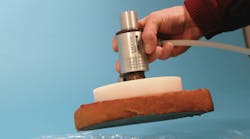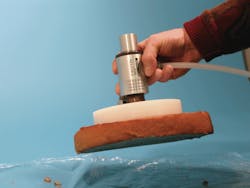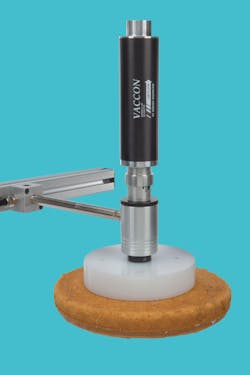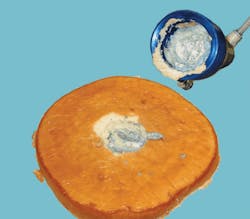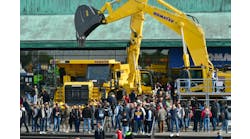A leading commercial bakery based in Colorado produces cakes and other baked goods for a wide range of customers across the western United States. Like any other manufacturer, it faces constant pressure to boost productivity and hold the line on costs.
According to the bakery’s production manager, one significant production bottleneck involved manually transferring cakes from conveyor lines to cartons. The process was slow; the delicate cakes were hard to handle and easily damaged; and the company had to deal with a lot of job dissatisfaction that comes from doing this tedious, repetitive-motion activity. Company management saw an opportunity to address these challenges and improve product quality by automating the process.
The goal was to develop a pick-and-place handling system for inserting the 10-in. round cakes and slip sheets into corrugated shipping cartons. The new machine would need to place 8 to 12 cakes with slip sheets into cartons at a rate of at least two cakes per second. And due to space constraints, placement of the cakes and slipsheets would have to be downward along the machine’s Z-axis.
Technical issues
The task seemed relatively straightforward for a vacuum-handling system. The problem, however,was that cake is technically a challenging material to handle with vacuum. Cake is porous, relatively heavy, crumbles easily, and has a variable density —it’s basically “floppy” stuff. Attempting to use vacuum and vacuum cups as handling mechanisms is doomed to fail because the cake will break easily, or the vacuum cups will mar and damage the cake surface.
Because the cakes and their slip sheets must be lowered into cartons, alternatives — such as grippers or lifting mechanisms —would not be practical because of the tight dimensions of the shipping carton’s interior. The solution would have to be vacuum, but used in a way that would accommodate the physical characteristics of cake.
There are millions of different vacuum cups on the market, along with thousands of pumps and blowers from various manufacturers. With any of them, it isn’t a question of will vacuum technology work, but how to apply vacuum technology. In this application, the engineers at Vaccon, Medway, Mass., determined that the solution was to use vacuum flow — a different approach compared to simply being concerned with vacuum level.
Vacuum flow is free air induced by a vacuum pump. When that air is constricted, it creates vacuum, the level of which is measured by the amount of constriction. The vacuum level is highest when the flow of free air is completely blocked. Because the cake is delicate and porous in this case, tightly controlling flow is crucial to generating a vacuum level high enough to hold the cake, but low enough to keep it from damaging the surface.
Engineering a solution
The pick-and-place system developed for this application needed to address the physical characteristics of cake and the vertical placement of the product into cartons. Another important issue was how to tolerate the ingestion of free cake crumbs present around the production line that would clog the average vacuum blower.
To accommodate the physical characteristics of the product, Vaccon developed a 6-in. diameter rigid cup composed of ultrahigh-molecular-weight polyethylene with mesh screening. The screening creates a greater surface area for suction, generating a vacuum head able to spread the vacuum tension over the entire top surface area of the cake without marring or dimpling.
A continuous vacuum flow is delivered by Vaccon CDF 750H adjustable air amplifiers with solenoid valves added for instant on-off control for pick-up and release. This is not a hard vacuum that must be released, but continuous flow and pressure controlled via solenoid valves.
The Vaccon-developed vacuum head and air amplifiers are mounted on an arm that moves the cakes from the end of the production line over the shipping carton and lowers them into the carton. The same process is applied to the slip sheets between the cakes.
The CDF adjustable air amplifiers operate based on the Coanda effect, where a small volume of compressed air is converted into a high output flow. Compressed air is emitted from an annular gap and passes over a curved surface in the throat of the unit. As air passes over this curved surface — similar to an air foil — a low pressure area is created that induces ambient air to flow into the throat with the compressed air.
Amplification ratio is up to 40:1, so the CDF amplifiers are a cost-effective alternative to using raw compressed air. The CDF amplifiers are also energy-efficient, unlike regenerative blowers that must run continuously. Incorporating the solenoid valve for the instant on-off control means the CDF need only be on when air is required.
The CDF air amplifiers’ straight-through design allows debris — in this case, cake crumbs — to pass through without clogging, providing maintenance-free operation. In addition, there are no moving parts to wear.
The CDF is non-heat-generating, compact, light weight, and easily installed. Standard units are made of anodized aluminum, but optional materials, such as stainless steel, Delrin, Teflon, and PVC, are available. They’re often used to handle challenging, porous objects such as egg-crate sheets, IV bags, perforated metal, fan scrolls, and circuit boards.
The new cake-handling system addressed the product’s physical characteristics, increased production throughput, and eliminated the need for worker involvement. The key was applying vacuum-flow technology as opposed to typical vacuum pick-and-place technology.
For more information on Vaccon’s air amplifiers and other vacuum systems, call (508) 359-7200 or visit www.vaccon.com.
